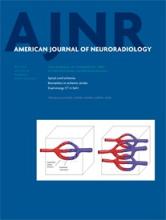Abstract
BACKGROUND AND PURPOSE: MR imaging findings of aneurysm enlargement, aneurysm wall enhancement, perianeurysmal edema, and embolic phenomena following deployment of flow-diverting stents may be relevant to those patients who subsequently experience procedure-related intracranial hemorrhage. We sought to document the routine early postoperative MR imaging findings following flow-diverting stent insertion.
MATERIALS AND METHODS: Patients requiring flow-diverting stent placement for treatment or retreatment of cerebral aneurysms were prospectively included in the study during a 26-month period. Early postprocedural MR imaging studies were obtained and compared with preoperative imaging. Patient clinical outcome data were also collected.
RESULTS: There were 34 stent-placement procedures during the study period. Aneurysm mural enhancement and mild new perianeurysmal edema were present in 50% and 14%, respectively. Any DWI lesion was present in 57% of cases. New or possibly new foci of susceptibility effect were found ipsilateral to the stent and not associated with diffusion restriction in 66% of cases. There were 2 cases (6%) of parenchymal hemorrhage and 2 major clinical complications (6%) causing permanent morbidity.
CONCLUSIONS: Asymptomatic aneurysm mural enhancement is frequently seen following flow-diverting stent placement and should not necessarily be interpreted as a sign of impending aneurysm rupture. This finding often persists despite complete aneurysm occlusion. New small brain parenchymal susceptibility foci following stent placement have not previously been reported, to our knowledge, but were common in our series.
- © 2015 by American Journal of Neuroradiology












